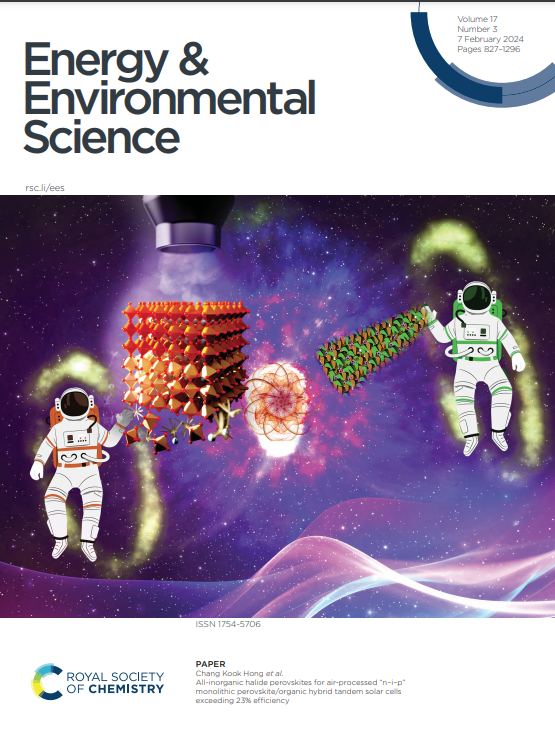过渡金属氧化物层内和层间离子电位调制的超高速率钠储存
IF 32.4
1区 材料科学
Q1 CHEMISTRY, MULTIDISCIPLINARY
引用次数: 0
摘要
虽然层状氧化物被认为是钠离子电池(sib)极有前途的阴极,但它们仍然存在结构稳定性差和Na+扩散动力学缓慢的问题,阻碍了它们在高电流速率下的循环稳定性。在此,我们展示了一种有效的离子电位调制策略,通过选择性地将具有不同离子电位的阳离子引入过渡金属(TM)层和层状氧化物的Na层,产生具有良好Na+扩散动力学的晶格稳定的层状氧化物。与注入高离子势的阳离子相反(Φ >;28.99 nm−1),在TM层中引入具有低离子势的阳离子(如Li+, 13.16 nm−1),可以促进晶格O2−周围的电子云向TM离子离域,从而构建独特的O-TM-O互锁构型,同时提高TM离子和晶格O2−的稳定性。同时,低离子电位的阳离子如K+ (7.25 nm−1)掺入Na层(Na+, 9.80 nm−1)引起K+-Na+静电相互作用减弱,从而降低了Na+扩散过程中的斥力。这些独特的特征不仅强化了TM层的骨架结构,而且促进了Na+层间扩散。因此,sib在50℃下具有78.7 mAh g−1的优异倍率性能和长达2000次循环的长期稳定性。本文章由计算机程序翻译,如有差异,请以英文原文为准。
Ionic Potential Modulation in and between Layers of Transition Metal Oxides towards Ultrahigh-Rate Sodium Storage
Although layered oxides have been considered as promising cathodes for sodium-ion batteries (SIBs), they still suffer from poor structural stability and sluggish Na+ diffusion kinetics, hampering their cycling stability at high current rates. Herein, we demonstrate an efficient ionic potential modulation strategy to produce a lattice-stable layered oxide with favorable Na+ diffusion kinetics via selective introduction of cations with different ionic potentials into transition metal (TM) layers and Na layers of layered oxides. In contrast to the implantation of cations with high ionic potentials (Φ > 28.99 nm−1), introducing cations with low ionic potentials (e.g., Li+, 13.16 nm−1) into TM layers enables to facilitate the delocalization of electron clouds around lattice O2− towards TM ions, thereby constructing a unique O-TM-O interlocking configuration to simultaneously improve the stability of TM ions and lattice O2−. Meanwhile, the incorporation of cations with low ionic potentials such as K+ (7.25 nm−1) into Na layers (Na+, 9.80 nm−1) induces an attenuated K+-Na+ electrostatic interaction, thus diminishing the repulsion during Na+ diffusion process. These unique features not only strengthen the skeletal structure of TM layers, but also promote the Na+ interlayer diffusion. Consequently, an excellent rate performance of 78.7 mAh g−1 at 50 C and a long-term stability up to 2000 cycles are achieved in SIBs.
求助全文
通过发布文献求助,成功后即可免费获取论文全文。
去求助
来源期刊

Energy & Environmental Science
化学-工程:化工
CiteScore
50.50
自引率
2.20%
发文量
349
审稿时长
2.2 months
期刊介绍:
Energy & Environmental Science, a peer-reviewed scientific journal, publishes original research and review articles covering interdisciplinary topics in the (bio)chemical and (bio)physical sciences, as well as chemical engineering disciplines. Published monthly by the Royal Society of Chemistry (RSC), a not-for-profit publisher, Energy & Environmental Science is recognized as a leading journal. It boasts an impressive impact factor of 8.500 as of 2009, ranking 8th among 140 journals in the category "Chemistry, Multidisciplinary," second among 71 journals in "Energy & Fuels," second among 128 journals in "Engineering, Chemical," and first among 181 scientific journals in "Environmental Sciences."
Energy & Environmental Science publishes various types of articles, including Research Papers (original scientific work), Review Articles, Perspectives, and Minireviews (feature review-type articles of broad interest), Communications (original scientific work of an urgent nature), Opinions (personal, often speculative viewpoints or hypotheses on current topics), and Analysis Articles (in-depth examination of energy-related issues).
 求助内容:
求助内容: 应助结果提醒方式:
应助结果提醒方式:


